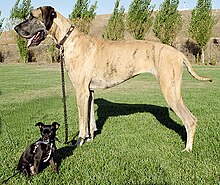Dog breed

A dog breed is a group of dogs that have very similar or nearly identical characteristics of appearance or behavior or, usually, both, primarily because they come from a select set of ancestors who had the same characteristics. Dogs have been selectively bred for specific characteristics for thousands of years. Initially the selections would have centered on domestication and useful behavior such as hunting ability. Later, dogs were also selected for attractive and distinctive forms, resulting in a vast variety of types.
Many traditional dog breeds recognized by the main breed registries are said to be "purebred". Only individuals whose parentage consists only of other purebred examples of the breed are regarded as part of that breed. This concept has caused controversy both because of the difficulty of regulation and because of the possible genetic consequences of a limited population (inbreeding). Recent work has been done to genetically classify the various breeds, with some surprising results regarding the estimated age and interrelations of the breeds.
Generally, before a type of dog is recognized as a true breed, it must be shown that mating a pair of that type always produces dogs that have the same characteristics as the parents, usually both in appearance and in behavior. This is known as breeding true. There are many issues concerning what is considered breeding true. For example, Flat-Coated Retrievers must always be black or dark brown; however, yellow coats occur occasionally in some litters. Kennel clubs do not recognize the yellow dogs as legitimate members of the breed; some breeders will kill the puppies rather than risk having the dog grow up, breed, and produce more of the undesired yellow color, perpetuating the undesirable gene; more often, today, such dogs are neutered and placed in homes as pets. As another example, a breeding pair of Belgian Shepherds of the Groenendael variety can produce puppies of the Tervuren (brown) variety; the AKC considers the varieties to be different breeds and, therefore, the brown puppies are invalid and undesirable dogs, whereas the CKC considers them simply to be different color varieties of the same breed.
See selective breeding for a detailed discussion on open versus closed stud books and some of the issues concerning purebreds.
See also
External links
- Just Dog Breeds
- Rare Dog Breeds
- Selecting the Right DogSelect the Dog that is compatible for you.
- AKC Dog Registration Statistics for 2003 and 2004
- All About Dog Breeds
- Dogs: Fun Facts and Trivia From AOL Research and Learn Photo Galleries
- Dog Breeds Retrieved from the web. Complete list and information detailing over four hundred breeds of dogs.
- The Online Dog Encyclopedia (worldwide)
- Dog Breed Photos and Information by Dog Public
